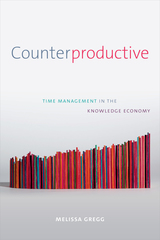4 books about Time Management

The Changing Rhythms of American Family Life
Suzanne M. Bianchi
Russell Sage Foundation, 2006
Over the last forty years, the number of American households with a stay-at-home parent has dwindled as women have increasingly joined the paid workforce and more women raise children alone. Many policy makers feared these changes would come at the expense of time mothers spend with their children. In Changing Rhythms of American Family Life, sociologists Suzanne M. Bianchi, John P. Robinson, and Melissa Milkie analyze the way families spend their time and uncover surprising new findings about how Americans are balancing the demands of work and family. Using time diary data from surveys of American parents over the last four decades, Changing Rhythms of American Family Life finds that—despite increased workloads outside of the home—mothers today spend at least as much time interacting with their children as mothers did decades ago—and perhaps even more. Unexpectedly, the authors find mothers' time at work has not resulted in an overall decline in sleep or leisure time. Rather, mothers have made time for both work and family by sacrificing time spent doing housework and by increased "multitasking." Changing Rhythms of American Family Life finds that the total workload (in and out of the home) for employed parents is high for both sexes, with employed mothers averaging five hours more per week than employed fathers and almost nineteen hours more per week than homemaker mothers. Comparing average workloads of fathers with all mothers—both those in the paid workforce and homemakers—the authors find that there is gender equality in total workloads, as there has been since 1965. Overall, it appears that Americans have adapted to changing circumstances to ensure that they preserve their family time and provide adequately for their children. Changing Rhythms of American Family Life explodes many of the popular misconceptions about how Americans balance work and family. Though the iconic image of the American mother has changed from a docile homemaker to a frenzied, sleepless working mom, this important new volume demonstrates that the time mothers spend with their families has remained steady throughout the decades.
[more]

Counterproductive
Time Management in the Knowledge Economy
Melissa Gregg
Duke University Press, 2018
As online distractions increasingly colonize our time, why has productivity become such a vital demonstration of personal and professional competence? When corporate profits are soaring but worker salaries remain stagnant, how does technology exacerbate the demand for ever greater productivity? In Counterproductive Melissa Gregg explores how productivity emerged as a way of thinking about job performance at the turn of the last century and why it remains prominent in the different work worlds of today. Examining historical and archival material alongside popular self-help genres—from housekeeping manuals to bootstrapping business gurus, and the growing interest in productivity and mindfulness software—Gregg shows how a focus on productivity isolates workers from one another and erases their collective efforts to define work limits. Questioning our faith in productivity as the ultimate measure of success, Gregg's novel analysis conveys the futility, pointlessness, and danger of seeking time management as a salve for the always-on workplace.
[more]

Fighting For Time
Shifting Boundaries of Work and Social Life
Cynthia Fuchs Epstein
Russell Sage Foundation, 2004
Though there are still just twenty-four hours in a day, society's idea of who should be doing what and when has shifted. Time, the ultimate scarce resource, has become an increasingly contested battle zone in American life, with work, family, and personal obligations pulling individuals in conflicting directions. In Fighting for Time, editors Cynthia Fuchs Epstein and Arne Kalleberg bring together a team of distinguished sociologists and management analysts to examine the social construction of time and its importance in American culture. Fighting for Time opens with an exploration of changes in time spent at work—both when people are on the job and the number of hours they spend there—and the consequences of those changes for individuals and families. Contributors Jerry Jacobs and Kathleen Gerson find that the relative constancy of the average workweek in America over the last thirty years hides the fact that blue-collar workers are putting in fewer hours while more educated white-collar workers are putting in more. Rudy Fenwick and Mark Tausig look at the effect of nonstandard schedules on workers' health and family life. They find that working unconventional hours can increase family stress, but that control over one's work schedule improves family, social, and health outcomes for workers. The book then turns to an examination of how time influences the organization and control of work. The British insurance company studied by David Collinson and Margaret Collinson is an example of a culture where employees are judged on the number of hours they work rather than on their productivity. There, managers are under intense pressure not to take legally guaranteed parental leave, and clocks are banned from the office walls so that employees will work without regard to the time. In the book's final section, the contributors examine how time can have different meanings for men and women. Cynthia Fuchs Epstein points out that professional women and stay-at-home fathers face social disapproval for spending too much time on activities that do not conform to socially prescribed gender roles—men are mocked by coworkers for taking paternity leave, while working mothers are chastised for leaving their children to the care of others. Fighting for Time challenges assumptions about the relationship between time and work, revealing that time is a fluid concept that derives its importance from cultural attitudes, social psychological processes, and the exercise of power. Its insight will be of interest to sociologists, economists, social psychologists, business leaders, and anyone interested in the work-life balance.
[more]

Self-Control in Seven Steps
Christine B. Whelan
Templeton Press, 2012
When you want to get up for an early flight, what do you do? You set an alarm. If you want to benchpress your body weight, how do you start? You slowly build up your muscles so you can achieve your goal. And when you’ve got a big deadline looming, what’s the best way to handle it? Plan out your time.
If you’re like most people, you know all these things are true, but at some point or another, you’ve dropped the ball: You’ve missed a flight because you cut it too close, you’ve overestimated what you can physically do, hurting yourself in the process, or you’ve tried to cram in a month’s worth of work into a frantic forty-eight-hour panic fest. Yes?
You’re not alone. Even Aristotle knew this when he said, “I count him braver who overcomes his desires than him who conquers his enemies; for the hardest victory is over self.”
You want the secret to success. You want to take control of your life and achieve your goals. We all do. Since research has repeatedly shown that self-control is like a muscle, think of this book as your personal trainer to build up your skills and strength. Self-Control in 7 Steps offers the proven mental tricks, organizational strategies, and tools to transform the bored, unfocused, and lazy in all of us.
[more]
READERS
Browse our collection.
PUBLISHERS
See BiblioVault's publisher services.
STUDENT SERVICES
Files for college accessibility offices.
UChicago Accessibility Resources
home | accessibility | search | about | contact us
BiblioVault ® 2001 - 2024
The University of Chicago Press









